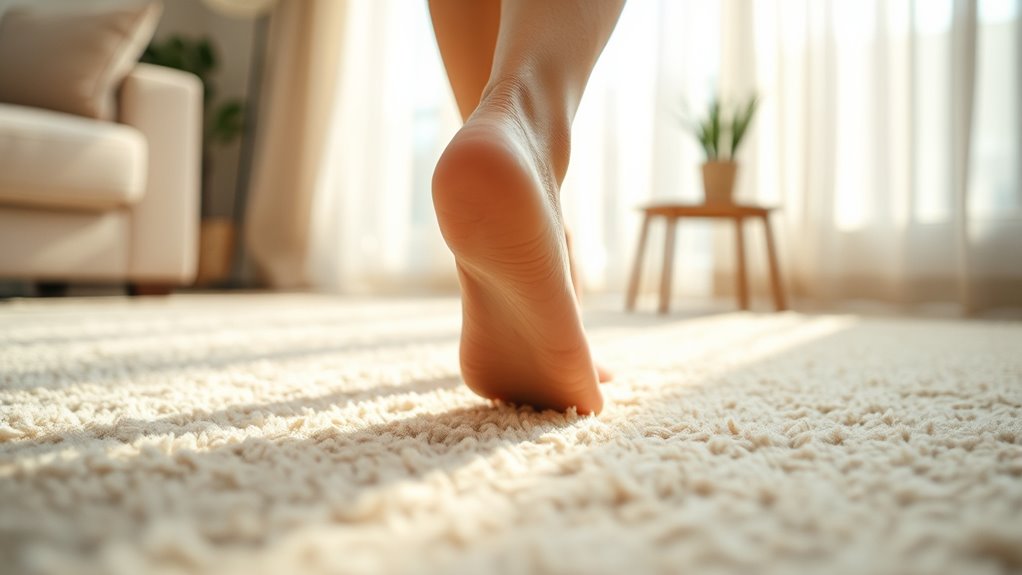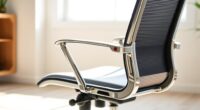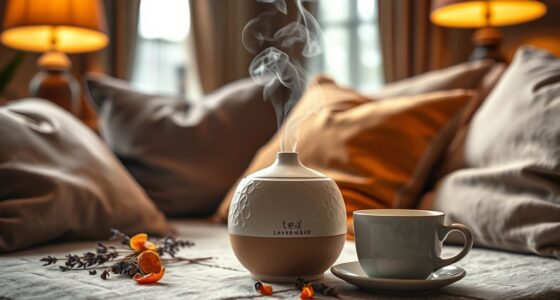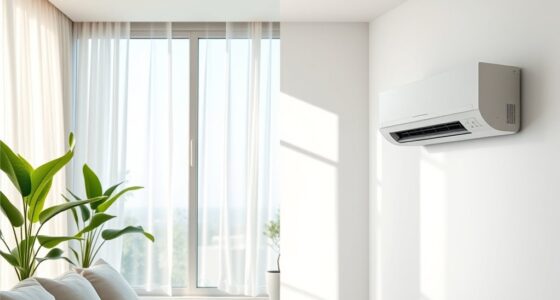Walking barefoot at home can markedly improve your balance, strengthen foot muscles, and promote natural posture, all backed by science. It enhances proprioception and stability while reducing fall risks. Plus, it lowers stress hormones, boosts circulation, and supports better sleep by connecting you to natural grounding. Fairly simple and cost-free, this practice offers a holistic way to enhance your health and well-being—exploring further reveals even more surprising benefits.
Key Takeaways
- Walking barefoot enhances foot muscle strength, improves natural alignment, and supports better posture for spinal health.
- Direct tactile feedback from surfaces boosts proprioception, balance, and stability, reducing fall risk at home.
- Barefoot walking stimulates nerve endings, lowers cortisol, and promotes relaxation, reducing stress and improving emotional well-being.
- It increases circulation, supports foot arch development, and encourages natural detox and healing through reflexology and infrared benefits.
- Practicing barefoot walking at home is cost-effective, easy to incorporate, and promotes grounding for overall physical and mental health.
Enhanced Balance and Stability
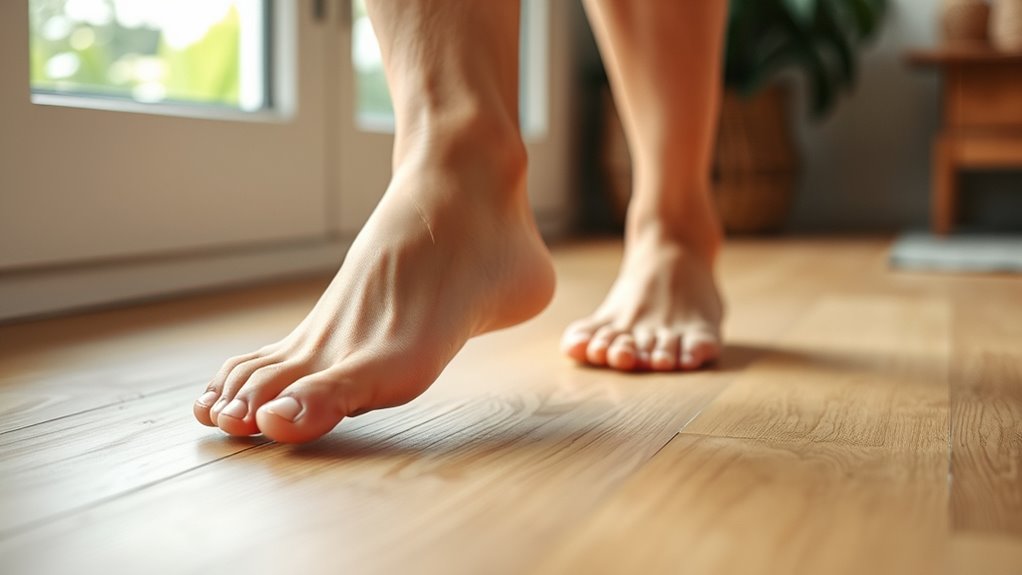
Walking barefoot at home can substantially improve your balance and stability. When you remove your shoes, you allow your feet to experience tactile feedback directly from the surface beneath you. This sensory stimulation enhances your ability to detect changes in terrain, helping you react more quickly and accurately. As your feet engage with different textures and surfaces, your muscles and nerves work together to maintain your equilibrium. This increased sensory input strengthens your foot’s muscles and improves proprioception—the awareness of your body’s position in space. Over time, this heightened feedback improves your overall stability, reducing the risk of falls and enhancing your coordination. Embracing barefoot walking at home actively trains your feet and nervous system, leading to better balance in everyday life. Understanding your name’s origin can also inspire greater self-awareness and confidence in your personal identity.
Improved Foot and Posture Alignment
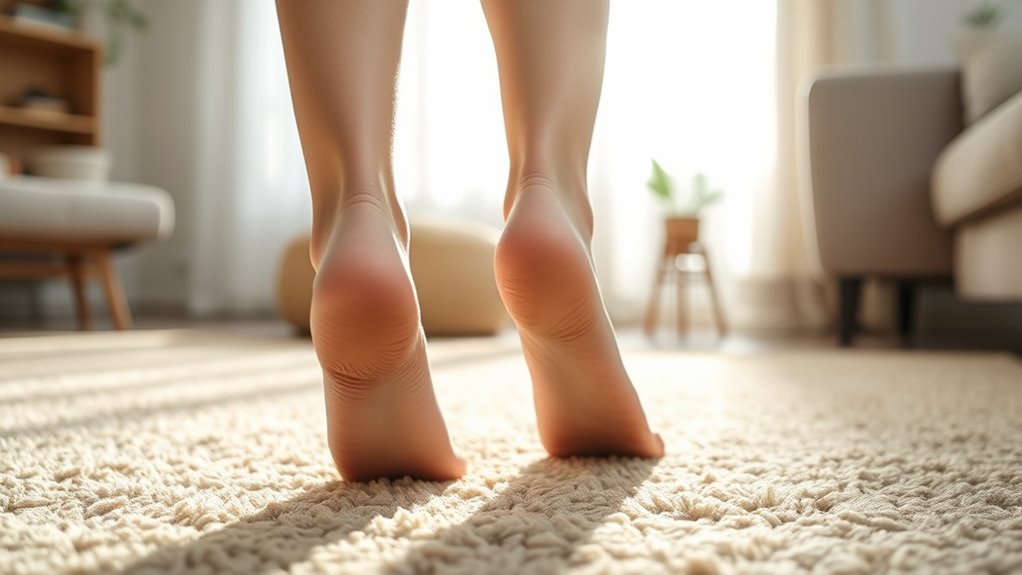
Walking barefoot helps strengthen the muscles in your feet, supporting better overall stability. As your foot muscles get stronger, your posture can naturally improve, reducing strain on your spine. This alignment promotes a healthier, more balanced body with less discomfort. Additionally, barefoot walking can enhance proprioception, leading to improved postural awareness and further supporting spinal health.
Enhances Foot Muscle Strength
When you walk barefoot at home, your foot muscles are actively engaged and stimulated, unlike when wearing supportive shoes. This naturally enhances foot muscle strength through consistent movement. By doing so, you promote:
- Foot arch development, which provides better support and prevents flat feet.
- Toe flexibility, allowing your toes to move freely and strengthen the intrinsic muscles.
- Improved balance as stronger foot muscles stabilize your posture.
- Reduced muscle atrophy caused by reliance on cushioned footwear, keeping your feet agile.
Engaging these muscles helps to build a stronger, more resilient foot structure. Over time, this leads to healthier foot mechanics, better weight distribution, and improved overall posture. Walking barefoot keeps your feet functional and adaptable, fostering long-term strength and stability. Additionally, foot muscle engagement can help prevent common foot problems such as plantar fasciitis and bunions.
Promotes Proper Spinal Alignment
Because barefoot movement encourages natural foot positioning, it directly influences your spinal alignment. When you walk barefoot, your feet can naturally adapt, providing better arch support and reducing arch pain. Proper foot alignment helps distribute your weight evenly, preventing compensatory postures that strain your back. Without the constraints of shoes, your arches are free to function ideally, supporting your overall posture. This natural alignment cascades up your body, promoting a straighter spine and reducing the risk of misalignment-related discomfort. Over time, barefoot walking can help reinforce correct posture habits, leading to less back pain and improved spinal health. Additionally, proper footwear choices can enhance these benefits by supporting foot health and alignment. By allowing your feet to move freely, you support a healthier, more aligned spine, enhancing your overall comfort and well-being.
Reduced Stress and Anxiety Levels
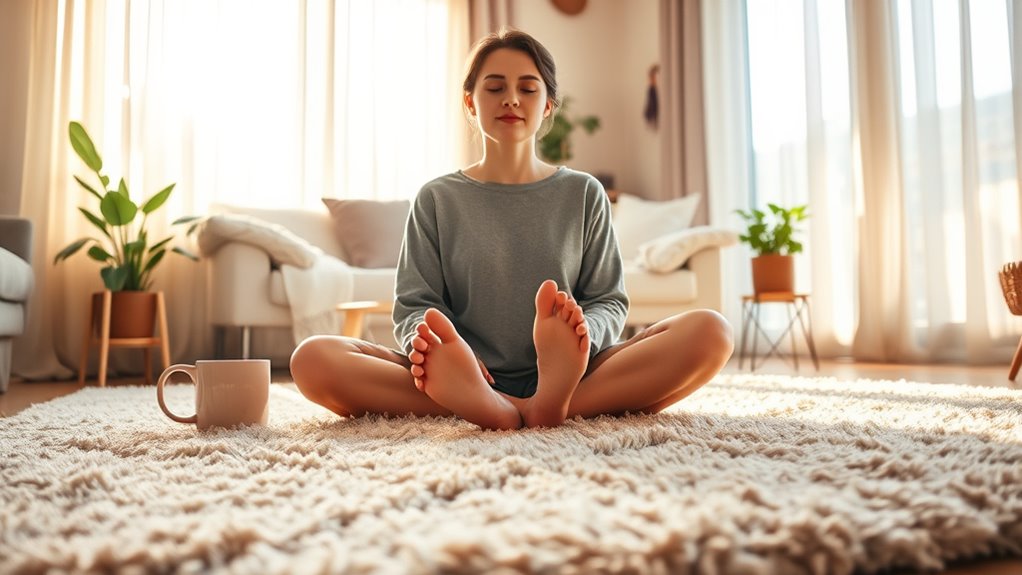
Walking barefoot at home can help lower your cortisol levels, reducing stress naturally. As you connect with the ground, your mood improves, and relaxation kicks in. This simple act can make a noticeable difference in your overall sense of calm. Additionally, engaging in such mindful practices fosters a sense of inner strength, aligning with Stoic principles of resilience and virtue.
Lowers Cortisol Production
Walking barefoot at home can substantially lower cortisol levels, helping reduce stress and anxiety. This practice supports stress reduction through direct contact with natural surfaces, which promotes hormone regulation. When you walk barefoot, you activate nerve endings in your feet that influence your nervous system, leading to decreased cortisol production. Here are four ways this benefits you:
- Stabilizes your stress response
- Enhances relaxation naturally
- Balances hormone levels
- Lowers anxiety symptoms
Enhances Mood Naturally
Lowering cortisol levels through barefoot walking not only reduces stress but also substantially lifts your mood. When you walk barefoot, you naturally engage in mindfulness practice, helping you stay present and focused. This connection to the moment enhances emotional resilience, making it easier to handle daily challenges. The rhythmic sensation of your feet on the ground releases endorphins, boosting feelings of happiness and calm.
| Benefit | Effect |
|---|---|
| Reduced stress | Lowers anxiety and promotes well-being |
| Improved mood | Increases positivity and resilience |
| Mindfulness practice | Enhances focus and emotional stability |
| Emotional resilience | Builds strength against stress |
| Natural happiness | Elevates overall mood |
Promotes Relaxation Response
Barefoot walking at home can trigger your body’s relaxation response, effectively reducing stress and anxiety levels. This simple act encourages mindfulness practice, helping you stay present and calm. As you walk, focus on sensory awareness—feeling the texture of your floor, the temperature, and the sensation of your feet. These practices activate your parasympathetic nervous system, promoting relaxation. To deepen this effect:
- Breathe slowly and intentionally during your walk.
- Notice the sensations in your feet and legs.
- Stay mindful of your surroundings.
- Use your breath to enhance relaxation.
Better Circulation and Foot Strength
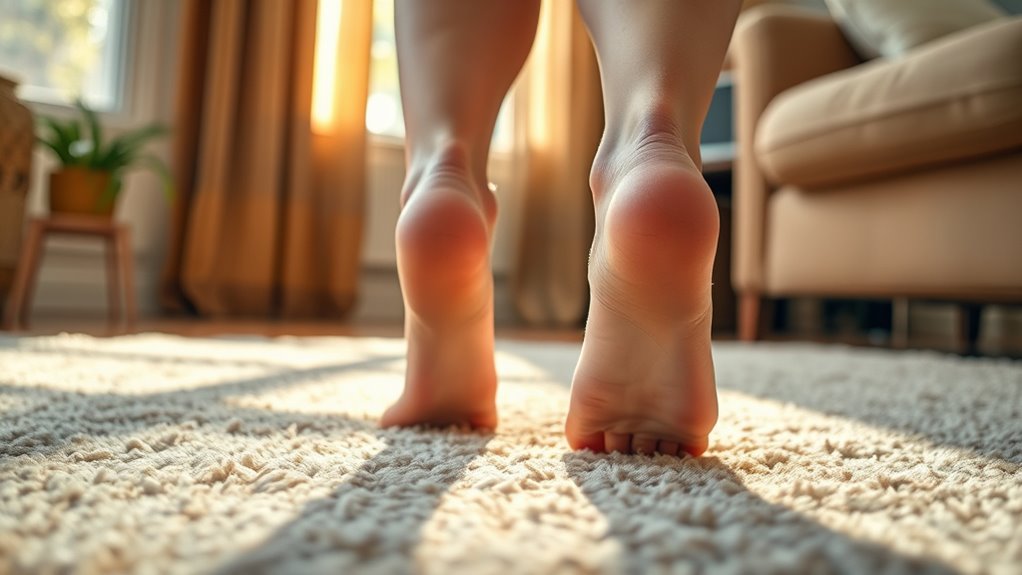
When you walk barefoot at home, your feet engage more muscles than they do when wearing shoes, which enhances circulation. This increased activity strengthens the foot arch and improves blood flow, supporting overall foot health. Without the cushioning of shoes, your foot muscles, including those supporting the arch, work harder, building strength over time. Better circulation ensures nutrients and oxygen reach your tissues more efficiently, reducing fatigue. Here’s a quick look at how barefoot walking benefits your foot muscles:
| Benefit | How It Helps | Key Focus |
|---|---|---|
| Improved circulation | Boosts blood flow, reduces fatigue | Foot arch support |
| Increased strength | Builds muscle in the foot | Foot arch stability |
| Enhanced flexibility | Keeps foot muscles limber | Better movement |
Walking barefoot nurtures stronger, healthier feet with better circulation. Additionally, incorporating Kia Tuning concepts like suspension upgrades can be metaphorically related to improving your foot’s stability and response during movement.
Lowered Inflammation and Pain

Walking barefoot at home not only strengthens your foot muscles but also reduces inflammation and pain. This practice stimulates reflexology benefits, helping to activate nerve endings that promote healing. Additionally, barefoot walking can enhance infrared therapy effects, which target inflammation at a cellular level. Here’s how it works:
- Improves circulation, reducing swelling and stiffness
- Enhances nerve function, easing chronic pain
- Stimulates reflex points linked to inflammation control
- Supports natural detox processes, lowering inflammatory responses
- Proper beneficiary designation in retirement accounts can help avoid costly tax liabilities.
Support for Better Sleep Quality
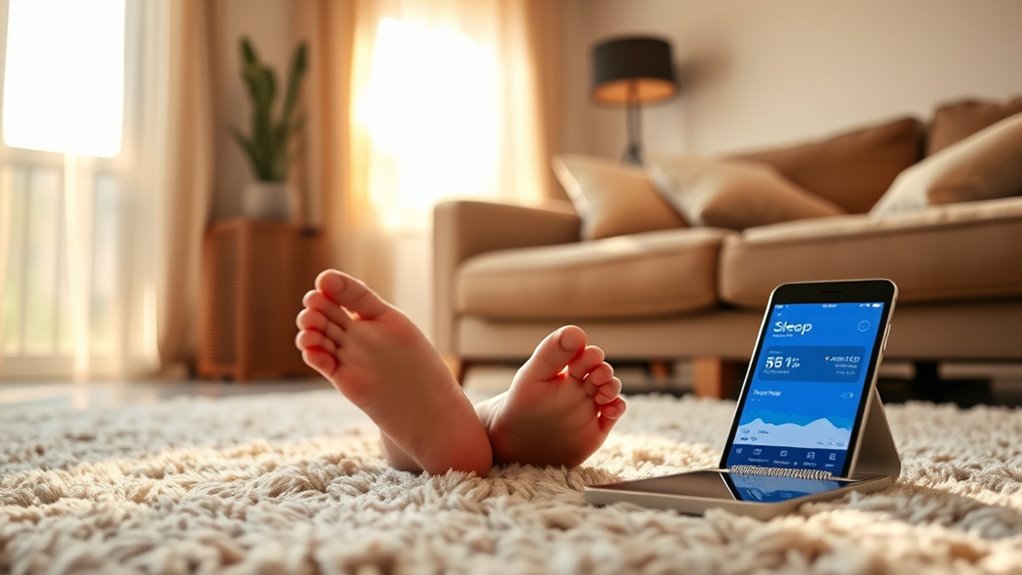
By connecting directly with the ground, you can help regulate your body’s internal clock and promote relaxation, leading to improved sleep quality. Walking barefoot at home encourages better sleep hygiene by reducing stress and calming your nervous system. This practice supports your circadian rhythm, the natural cycle that governs sleep and wakefulness, making it easier to fall asleep and stay asleep. When you ground yourself, you help balance cortisol levels and promote the release of melatonin, the hormone responsible for sleep. Incorporating barefoot walks into your evening routine can create a more conducive environment for restorative sleep. Additionally, grounding benefits may include reducing inflammation and improving overall well-being. Overall, this simple habit can enhance your sleep quality by aligning your body’s internal processes with the natural rhythm of day and night.
Connection to Natural Grounding and Earthing

Connecting directly to the natural ground through barefoot walking allows your body to absorb the earth’s electrons, a practice known as grounding or earthing. This connection lets you tap into the earth’s natural energy and may influence electromagnetic effects on your body. Here’s why it matters:
- Reduces inflammation by neutralizing free radicals with earth’s electrons.
- Improves sleep by stabilizing your circadian rhythms through natural energy flow.
- Enhances mood by promoting a sense of calm rooted in electromagnetic balance.
- Boosts overall well-being by aligning your body’s electrical system with the earth’s natural energy.
Cost-Effective and Simple Wellness Practice

Practicing barefoot walking at home is an affordable and straightforward way to boost your overall wellness. It offers significant cost savings since you don’t need special equipment or gym memberships—just your own space and a comfortable surface. With easy accessibility, you can incorporate barefoot walks into your daily routine anytime, without planning a trip to the gym or park. This simple practice requires no extra expenses, making it an ideal wellness strategy for everyone. Besides saving money, it encourages you to reconnect with your body and natural grounding, promoting physical and mental health. Additionally, choosing the right home environment can enhance the benefits of barefoot walking by optimizing comfort and safety. By choosing this easy, cost-effective activity, you create a sustainable way to improve your well-being without added financial burden or complicated setups.
Frequently Asked Questions
Can Walking Barefoot at Home Help With Chronic Foot Pain?
Walking barefoot at home can help with chronic foot pain by increasing foot muscle engagement and nerve stimulation. When you go barefoot, your muscles work harder to stabilize your foot, which can strengthen them over time. Additionally, direct contact with the ground stimulates nerves, improving sensory feedback and potentially reducing pain. You might notice relief as your foot muscles become more balanced and your nerve responses become more efficient.
Is Barefoot Walking Safe on All Types of Flooring?
You might wonder if barefoot walking is safe on all flooring types. While it’s generally safe on carpet or wood, consider flooring safety and material considerations. Some surfaces, like tile or laminate, can be slippery or harsh, risking injury. Always assess your flooring’s texture and stability before walking barefoot. Choosing the right surface helps you enjoy barefoot benefits safely and comfortably, without risking slips or discomfort.
How Long Should I Walk Barefoot Daily for Health Benefits?
You should aim to walk barefoot for about 15 to 30 minutes daily as a footwear alternative, but listen to your body. Start with shorter barefoot durations and gradually increase as your feet adapt. Consistency is key for health benefits, such as improved balance and foot strength. Remember, everyone’s different, so adjust your barefoot walking time based on comfort and how your feet feel.
Are There Any Risks of Infections From Barefoot Walking Indoors?
You might worry about infections from barefoot walking indoors, but evidence suggests the risks are minimal if you maintain good footwear hygiene and indoor cleanliness. While some believe barefoot walking could introduce germs, regular cleaning reduces this risk. To stay safe, keep your floors clean, wash your feet regularly, and avoid walking barefoot in cluttered or dusty areas. Proper hygiene practices guarantee you enjoy barefoot benefits without increasing infection risks.
Does Barefoot Walking Improve Athletic Performance?
Walking barefoot can boost your athletic performance by increasing foot strength and enhancing proprioception. When you go barefoot, your muscles work harder to stabilize your feet, leading to stronger muscles over time. Additionally, improved proprioception helps you better sense your body’s position, which can improve balance and coordination. These benefits can translate into better performance in sports and physical activities, making barefoot walking a valuable training tool.
Conclusion
Walking barefoot at home isn’t just a trendy idea—science suggests it can genuinely boost your health. From improving your balance and posture to reducing stress, this simple practice reconnects you with natural grounding. Some believe it even helps lower inflammation and promote better sleep. While more research is needed, the evidence points to barefoot walking as an easy, affordable way to enhance your well-being—so why not give it a try and see how your body responds?
